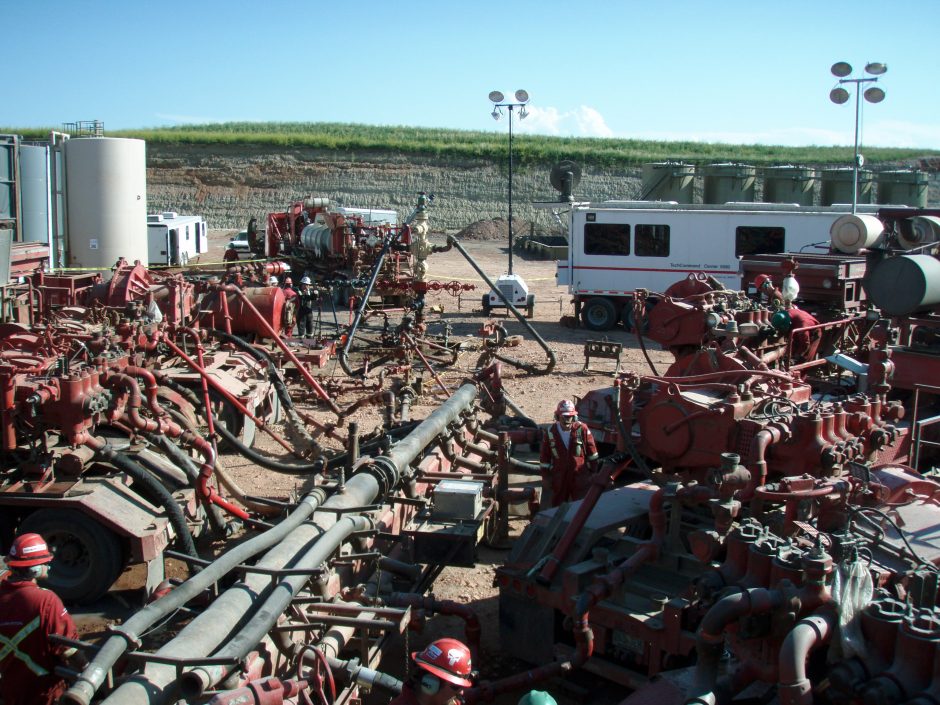Too Close for Comfort: About Half of Fracking Wells 2 to 3 km From Domestic Groundwater Systems

By Joshua Doubek (Own work) [CC BY-SA 3.0 (https://creativecommons.org/licenses/by-sa/3.0)]
If you live in a city, you may take the safety of the water that you drink for granted, although recent developments in Flint may have changed your mind about that. But for 45 million Americans who drink water that comes from private wells, drawn from groundwater and unregulated by a public utility, the question of what’s in that water is an even bigger unknown—a potentially dangerous one.
In 2016, the Environmental Protection Agency (EPA) released a report indicating that supplies of drinking water near hydraulic-fracturing or fracking sites are more likely to be affected by contamination events. Scott Jasechko and Debra Perrone, Researchers at the University of California Santa Barbara, wanted to find out just how many privately-owned groundwater wells might be at risk.
Finding and analyzing the data
The researchers compiled a sizable database of private drinking water wells and compared their locations to fracking sites.
“We accessed groundwater well construction data from state-level databases and hydraulically fractured well data from FracFocus, which is a chemical registry database curated by the Groundwater Protection Council and Interstate Oil and Gas Compact Commission,” Jasechko details. “By merging these two datasets, we were able to compare locations of self-supply and hydraulically fractured wells.”
They next analyzed data from almost 27,000 wells in 14 states between 2000 and 2014. They discovered that by 2014, around half of all hydraulically fractured wells stimulated were within 2 to 3 kilometers of a domestic groundwater well, revealing a pressing need for increased water monitoring efforts near both conventional oil and gas wells and hydraulically fractured wells.
“Thousands of spills have been reported at hydraulic fracturing sites,” Jasechko explains. “The Environmental Protection Agency identified ‘457 hydraulic fractured related spills’ in a study focusing on the hydraulic fracturing process itself. More recent work led by Dr. Lauren Patterson identified thousands of spills at hydraulically fractured wells, and the authors estimate that spills may occur at 2 to 16 percent of hydraulically fractured well sites.”
And this problem isn’t unique to fracking, as the study’s findings indicate.
“Oil and gas wells are known to leak on occasion due to structural imperfections in cement or casing barriers,” Jasechko clarifies. “Sustained casing pressures lead to leaks as oil and gas wells age. Operators of approximately 6 percent of wells accessing the Marcellus Shale in Pennsylvania have reported infringements pertaining to well integrity.”

Fracking diagram. (Credit: By US Environmental Protection Agency [Public domain])
Tracking hotspots
Jasechko and Perrone charted their data on a variety of maps, including one they used to track hotspots—areas where contamination is likely and limited resources exist for assessing the integrity of wells and the frequency of spills. In these hotspots, resource use could be more efficient and effective. This kind of focus on resources would also allow researchers to learn more about how often contamination events happen, and how to control and prevent them.
“Because hydraulic fracturing frequently takes place within a couple of miles of private water wells, and because the EPA has concluded these activities may potentially impact water quality, it is important we determine how frequently hydraulic fracturing activities may impact groundwater quality to preserve clean drinking water for many Americans that rely on private wells,” Jasechko explains.
Policy implications
Moving forward, determining how often hydraulic fracturing affects the quality of groundwater will be critical to maintaining high-quality water in many domestic wells, given their proximity to these sites. This suggests that the hotspots identified in this work should be targeted for further water-quality monitoring.
“Current requirements for groundwater quality monitoring before, during, and following hydraulic fracturing can be improved, substantially,” Jasechko asserts. “Hydraulic fracturing activities frequently take place nearby private water wells. Repeatedly testing these well waters for their quality prior to, during and following hydraulic fracturing could help to ensure high quality water can continue to be pumped for household uses.”
Furthermore, there are risks posed by conventional oil and gas wells along with fracking sources, and the risk these installments pose to water quality is not always understood by well owners.
“Many of the potential contamination mechanisms in the hydraulic fracturing water cycle are also present in more conventional oil and gas production activities,” comments Jasechko. “Further water quality testing of private wells located close by conventional and hydraulically fractured wells could be a step in the right direction.”
Jasechko emphasizes the importance of collaboration between scientists and members of the public to achieving success with risk management, and recommends further resources for anyone hoping to learn more about this research.
“The importance of pure drinking water is something we can all appreciate,” he remarks. “The ‘SNAPP’ working group has put together a map of some of the spills related to hydraulic fracturing that I recommend to readers interested in learning more about this process.”

Screen shot. “Visualizing Spills Data from Unconventional Oil and Gas Activity” tool, SNAPP. (Credit: SNAPP, Science for Nature and People Partnership.)
Top image: Fracking operation.(Credit: By Joshua Doubek (Own work) [CC BY-SA 3.0 (https://creativecommons.org/licenses/by-sa/3.0)]




0 comments